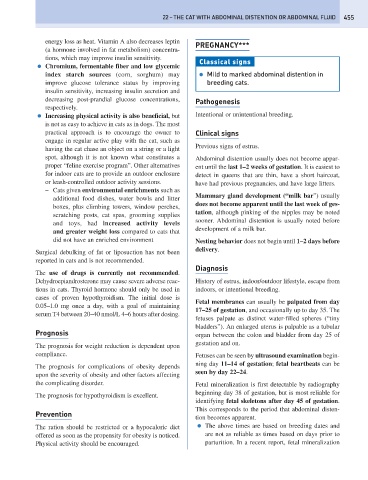Page 463 - Problem-Based Feline Medicine
P. 463
22 – THE CAT WITH ABDOMINAL DISTENTION OR ABDOMINAL FLUID 455
energy loss as heat. Vitamin A also decreases leptin
PREGNANCY***
(a hormone involved in fat metabolism) concentra-
tions, which may improve insulin sensitivity.
Classical signs
● Chromium, fermentable fiber and low glycemic
index starch sources (corn, sorghum) may ● Mild to marked abdominal distention in
improve glucose tolerance status by improving breeding cats.
insulin sensitivity, increasing insulin secretion and
decreasing post-prandial glucose concentrations, Pathogenesis
respectively.
● Increasing physical activity is also beneficial, but Intentional or unintentional breeding.
is not as easy to achieve in cats as in dogs. The most
practical approach is to encourage the owner to Clinical signs
engage in regular active play with the cat, such as
Previous signs of estrus.
having the cat chase an object on a string or a light
spot, although it is not known what constitutes a Abdominal distention usually does not become appar-
proper “feline exercise program”. Other alternatives ent until the last 1–2 weeks of gestation. It is easiest to
for indoor cats are to provide an outdoor enclosure detect in queens that are thin, have a short haircoat,
or leash-controlled outdoor activity sessions. have had previous pregnancies, and have large litters.
– Cats given environmental enrichments such as
Mammary gland development (“milk bar”) usually
additional food dishes, water bowls and litter
does not become apparent until the last week of ges-
boxes, plus climbing towers, window perches,
tation, although pinking of the nipples may be noted
scratching posts, cat spas, grooming supplies
sooner. Abdominal distention is usually noted before
and toys, had increased activity levels
development of a milk bar.
and greater weight loss compared to cats that
did not have an enriched environment Nesting behavior does not begin until 1–2 days before
delivery.
Surgical debulking of fat or liposuction has not been
reported in cats and is not recommended.
Diagnosis
The use of drugs is currently not recommended.
Dehydroepiandrosterone may cause severe adverse reac- History of estrus, indoor/outdoor lifestyle, escape from
tions in cats. Thyroid hormone should only be used in indoors, or intentional breeding.
cases of proven hypothyroidism. The initial dose is
Fetal membranes can usually be palpated from day
0.05–1.0 mg once a day, with a goal of maintaining
17–25 of gestation, and occasionally up to day 35. The
serum T4 between 20–40 nmol/L 4–6 hours after dosing.
fetuses palpate as distinct water-filled spheres (“tiny
bladders”). An enlarged uterus is palpable as a tubular
Prognosis organ between the colon and bladder from day 25 of
gestation and on.
The prognosis for weight reduction is dependent upon
compliance. Fetuses can be seen by ultrasound examination begin-
ning day 11–14 of gestation; fetal heartbeats can be
The prognosis for complications of obesity depends
seen by day 22–24.
upon the severity of obesity and other factors affecting
the complicating disorder. Fetal mineralization is first detectable by radiography
beginning day 38 of gestation, but is most reliable for
The prognosis for hypothyroidism is excellent.
identifying fetal skeletons after day 45 of gestation.
This corresponds to the period that abdominal disten-
Prevention
tion becomes apparent.
The ration should be restricted or a hypocaloric diet ● The above times are based on breeding dates and
offered as soon as the propensity for obesity is noticed. are not as reliable as times based on days prior to
Physical activity should be encouraged. parturition. In a recent report, fetal mineralization

